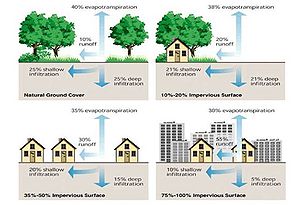
Overview of stormwater infiltration
This site is under construction. Anticipated completion date is June, 2015.
Stormwater infiltration is the process by which rainfall and stormwater runoff flows into and through the subsurface soil. Stormwater infiltration occurs when rainfall lands on pervious surfaces, when runoff flows across pervious surfaces, and when runoff is collected and directed to a stormwater infiltration Best Management Practice (BMP).
Current stormwater management policies encourage, when appropriate, maximizing the infiltration of stormwater to reduce the volume of runoff discharging to surface waters. In addition to reducing runoff volume, stormwater infiltration helps reduce stormwater pollutant loading to surface waters. Many factors influence the rate and volume of stormwater infiltration including soil characteristics, storage capacity, and vegetation. These and other factors are discussed in further detail in subsequent sections. Once stormwater infiltrates into the soil, it has the potential to enter the groundwater and become part of the subsurface flow. For the purposes of this section, infiltration BMPs are considered those without underdrains.
Basic concepts of stormwater infiltration
Stormwater runoff is considered to be any water that runs off pervious and impervious surfaces after a rainfall or snowmelt event, with a greater percentage running off from impervious surfaces. In urban areas, runoff can constitute approximately 30 to 55 percent of the water budget. In comparison, runoff may constitute as little as 10 percent in forested or rural areas (FISRWG, 1998).
Role of Stormwater Infiltration in the Natural Water Cycle
The increase in impervious surfaces can disrupt the natural water cycle and alter the surrounding environment via the decrease of groundwater recharge and the increase of water directly flowing to surface waters. As a likely consequence, this can lead to a reduction in the baseflow to streams, a decrease in the elevation of the groundwater table, and transport of sediment and pollutant loads into surface waters. A more detailed explanation of stormwater runoff and its effects on the environment can be found here.
Stormwater infiltration in urban areas can be enhanced by the disconnection of impervious surfaces and by the improvement of pervious surfaces such as turf. Impervious surface disconnection is the direction or redirection of stormwater runoff from impervious surfaces (e.g., sidewalks, parking lots, rooftops, etc.) onto pervious surfaces such as a roof drain discharging onto a lawn. Redirection of impervious surface runoff to pervious areas promotes infiltration and reduces overall site runoff. The reduction in site runoff from impervious surface disconnection can vary considerably depending on many factors including the size of the contributing drainage area, size and infiltration capacity of the soils, vegetation in the area receiving the additional stormwater, slope and site grading and other site conditions. Stormwater infiltration can also be enhanced by improvement of pervious surfaces, such as amending soil with compost to increase the water holding capacity of the soil.
In new developments, stormwater infiltration is often intended to mimic the natural hydraulic cycle. Stormwater infiltration in re-development aims to mitigate changes in the urban water cycle brought about by increases in impervious surfaces caused by the urbanization. Infiltration can achieve the following objectives:
- Decrease peak runoff flow rates
- Decrease the volume of stormwater runoff
- Reduce stormwater pollutant loading to surface waters
- Promote retention and breakdown of contaminants in the soil/act as a pollutant barrier between the land surface and groundwater
- Increase groundwater recharge
- Preserve base flow in streams
- Reduce thermal impacts of stormwater runoff
Typically, stormwater from disconnected impervious surfaces is routed to a stormwater BMP. Infiltration BMPs achieve the above objectives by capturing, retaining, and infiltrating stormwater. Infiltration BMPs consist of:
- Infiltration basins
- Infiltration trenches
- Bioretention-bioinfiltration (most often a rain garden)
- Permeable pavements
- Tree trenches/tree boxes (sometimes considered a form of bioretention)
Small and medium sized infiltration BMPs are often located at the beginning of a stormwater treatment train, while larger systems are often placed at the end of the train. These BMPs can also be installed as off-line treatment systems. Infiltration BMPs are most suitable in sites with permeable soils and sufficient separation from the seasonally high groundwater table, bedrock, and polluted sites.
Please note that while infiltration practices can remove some types of physical and chemical pollutants, careful consideration should be given to implementing stormwater infiltration practices in potential stormwater hotspots (PSH) or at sites with known pollution issues such as brownfields.
